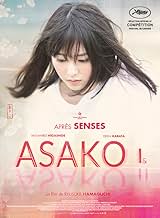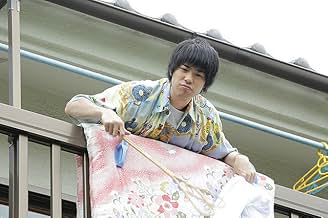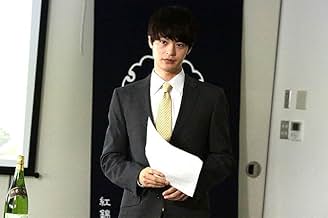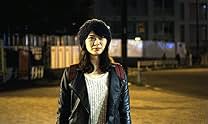IMDb-BEWERTUNG
7,0/10
5551
IHRE BEWERTUNG
Asako lebt in Osaka. Sie verliebt sich in Baku. Eines Tages verschwindet er. Zwei Jahre später lebt Asako nun in Tokio und lernt Ryohei kennen. Er sieht genauso aus wie Baku, hat aber eine g... Alles lesenAsako lebt in Osaka. Sie verliebt sich in Baku. Eines Tages verschwindet er. Zwei Jahre später lebt Asako nun in Tokio und lernt Ryohei kennen. Er sieht genauso aus wie Baku, hat aber eine ganz andere Persönlichkeit.Asako lebt in Osaka. Sie verliebt sich in Baku. Eines Tages verschwindet er. Zwei Jahre später lebt Asako nun in Tokio und lernt Ryohei kennen. Er sieht genauso aus wie Baku, hat aber eine ganz andere Persönlichkeit.
- Auszeichnungen
- 3 Gewinne & 10 Nominierungen insgesamt
Handlung
WUSSTEST DU SCHON:
- WissenswertesThe script utilizes homonym confusion about the character name Baku, the pronunciation of which is used for three different meanings:
- a mythological creature that is said to eat up nightmares, which Haruyo alludes to when she first appears in a yakiniku bar
- cereal crops like wheat or barley except for rice, which the kanji for the character name refers to, the same usage as in the title name "Bakushû" (Early Summer, or literally, "Barley Autumn") by Yasujirô Ozu
- the animal tapir, when Ryôhei talks about the zoo and searches images on the smartphone.
- VerbindungenFeatured in Fandor: Cannes You Dig It? | Fandor Spotlight (2022)
Ausgewählte Rezension
Emergent Japanese filmmaker Ryûsuke Hamaguchi, after his international breakthrough HAPPY HOUR (2015), is welcomed to Cannes' main competition for its follow up ASAKO I & II, an adaptation of Tomoka Shibasaki's 2010 novel.
The story traces a threadbare template of a young woman Asako's (newcomer Karata in her first film) internal struggle between two men Bako and Ryohei (both played by Higashide), who look just like each other but equipped with polarized personalities. After a prologue setting in Osaka, delineates the evanescent passion between Asako and Bako, the meat of the story relocates Asako to Tokyo, two years after Bako vanishes from her life apropos of nothing, she works in a coffee shop and bumps into Ryohei, a sake company salaryman with an uncanny resemblance of Bako, only, Ryohei turns out to be a gregarious, straight-arrow type that is nothing similar to Bako's enigmatic, ethereal insouciance.
Initially shocked to her core, Asako is gradually won over by many virtues Ryohei exhibits and after a tentative consent of his courtship, their wavering commitment is significantly cemented by the Great East Japan Earthquake in 2011, 6 years later, the present day, they are still together and Asako truly grows into a deeper affection to Ryohei, but a reunion with Hayuro (Itô), her best friend in Osaka, augurs the ineluctable re-entry of Bako, now a celebrated heartthrob, into her life, just after she comes clean her relationship with Bako to Ryohei (who confesses that he has divined a thing or two in the past years) and gallantly waves adieu to that seemingly closed chapter in the life, when the crunch comes, her impulsive reaction betrays the complexity of her id, after a dreamlike nocturnal driving on the highway with her knight in shining armor, she comes to a sudden awakening, and has a daunting job to win over Ryohei's heart again, or maybe not, Hamaguchi imbues a realistic spin in their final shot, both looking right into the camera to their indeterminate future.
Conceptually and thematically evoking Ozon's DOUBLE LOVER (2017), plus as its English title reveals, ASAKO I & II, Hamaguchi's conceit actually zooms in on Asako's dual oscillation (the idealized versus the realistic version of her affection) rather than on his literally doubled male protagonists, but through Karata's passive gaze, quiet performance and greenness, that oscillation is all to well buried underneath whereas Higashide lights up the screen with his compassionate incarnation of an ultimate good guy unfairly taking the short end of the stick in their lopsided relationship, thus the twofold revelations come off as a shade over-dramatic albeit Hamaguchi proves to be a superlative raconteur, it is not an easy job to weave a banal love triangle into an organic entity of compelling watching, and somehow, he manages that with great distinction, especially by conducting a tooth-comb of the narrative arc through supporting characters.
Apart from his gazing-at-the-lens MO (Asako, first meets Bako, then with Royhei in two Shigeo Gocho's SELF AND OTHERS exhibitions, tacitly carries off the parallels), Hamaguchi also struts his stuff with an aptitude with lights and scenic composition, betokened by the gradation of sunlight shadowing the rain-dappled field in the aerial shot near the end. All in all, ASAKO I & II is an auspicious discovery of a new Japanese auteur in the vein of Hirokazu Koreeda and Naomi Kawase, that is something every cineaste should extol!
The story traces a threadbare template of a young woman Asako's (newcomer Karata in her first film) internal struggle between two men Bako and Ryohei (both played by Higashide), who look just like each other but equipped with polarized personalities. After a prologue setting in Osaka, delineates the evanescent passion between Asako and Bako, the meat of the story relocates Asako to Tokyo, two years after Bako vanishes from her life apropos of nothing, she works in a coffee shop and bumps into Ryohei, a sake company salaryman with an uncanny resemblance of Bako, only, Ryohei turns out to be a gregarious, straight-arrow type that is nothing similar to Bako's enigmatic, ethereal insouciance.
Initially shocked to her core, Asako is gradually won over by many virtues Ryohei exhibits and after a tentative consent of his courtship, their wavering commitment is significantly cemented by the Great East Japan Earthquake in 2011, 6 years later, the present day, they are still together and Asako truly grows into a deeper affection to Ryohei, but a reunion with Hayuro (Itô), her best friend in Osaka, augurs the ineluctable re-entry of Bako, now a celebrated heartthrob, into her life, just after she comes clean her relationship with Bako to Ryohei (who confesses that he has divined a thing or two in the past years) and gallantly waves adieu to that seemingly closed chapter in the life, when the crunch comes, her impulsive reaction betrays the complexity of her id, after a dreamlike nocturnal driving on the highway with her knight in shining armor, she comes to a sudden awakening, and has a daunting job to win over Ryohei's heart again, or maybe not, Hamaguchi imbues a realistic spin in their final shot, both looking right into the camera to their indeterminate future.
Conceptually and thematically evoking Ozon's DOUBLE LOVER (2017), plus as its English title reveals, ASAKO I & II, Hamaguchi's conceit actually zooms in on Asako's dual oscillation (the idealized versus the realistic version of her affection) rather than on his literally doubled male protagonists, but through Karata's passive gaze, quiet performance and greenness, that oscillation is all to well buried underneath whereas Higashide lights up the screen with his compassionate incarnation of an ultimate good guy unfairly taking the short end of the stick in their lopsided relationship, thus the twofold revelations come off as a shade over-dramatic albeit Hamaguchi proves to be a superlative raconteur, it is not an easy job to weave a banal love triangle into an organic entity of compelling watching, and somehow, he manages that with great distinction, especially by conducting a tooth-comb of the narrative arc through supporting characters.
Apart from his gazing-at-the-lens MO (Asako, first meets Bako, then with Royhei in two Shigeo Gocho's SELF AND OTHERS exhibitions, tacitly carries off the parallels), Hamaguchi also struts his stuff with an aptitude with lights and scenic composition, betokened by the gradation of sunlight shadowing the rain-dappled field in the aerial shot near the end. All in all, ASAKO I & II is an auspicious discovery of a new Japanese auteur in the vein of Hirokazu Koreeda and Naomi Kawase, that is something every cineaste should extol!
- lasttimeisaw
- 4. Apr. 2019
- Permalink
Top-Auswahl
Melde dich zum Bewerten an und greife auf die Watchlist für personalisierte Empfehlungen zu.
- How long is Asako I & II?Powered by Alexa
Details
- Erscheinungsdatum
- Herkunftsländer
- Offizielle Standorte
- Sprachen
- Auch bekannt als
- Asako I & II
- Drehorte
- Produktionsfirmen
- Weitere beteiligte Unternehmen bei IMDbPro anzeigen
Box Office
- Bruttoertrag in den USA und Kanada
- 25.559 $
- Eröffnungswochenende in den USA und in Kanada
- 5.690 $
- 19. Mai 2019
- Weltweiter Bruttoertrag
- 645.313 $
- Laufzeit1 Stunde 59 Minuten
- Farbe
- Seitenverhältnis
- 1.66 : 1
Zu dieser Seite beitragen
Bearbeitung vorschlagen oder fehlenden Inhalt hinzufügen

Oberste Lücke
What is the Brazilian Portuguese language plot outline for Ob wir schlafen oder wachen (2018)?
Antwort





















